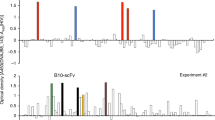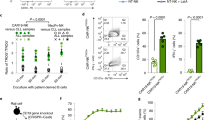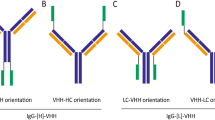Abstract
We have developed a novel immunostimulatory molecule against tumor cells, composed of an anti-FcγRIII (CD16) scFv fused to the platelet-derived growth factor receptor (PDGFR) transmembrane region. This fusion molecule was stably expressed on the tumor cell surface and retained the ability of the parental antibody to bind soluble CD16. Tumor cells expressing anti-CD16 scFv triggered the release of IL-2 by Jurkat-CD16/γ cells and of TNFα by monocytes when co-cultured with these cells. Furthermore, NK cells could kill scFv-transfected HLA+ class I H1299 lung carcinoma tumor cells, but not the parental cells, indicating that anti-CD16 scFv tumor expression prevents the killer inhibitory receptor (KIR)-mediated inhibition of NK cell cytotoxicity. This anti-CD16 scFv tumor expression also enhanced tumor phagocytosis by IFNγ-activated macrophages, a mechanism known to induce a protective long-term adaptative immunity to tumors. In vivo Winn tests performed in SCID mice showed that the expression of anti-CD16 scFv on tumor cells, but not of the negative control anti-phOx scFv, prevented tumor cell growth. Thus, expression of FcR antibodies or other FcR-specific ligands on tumor cells represents a novel and potent antibody-based gene therapy approach, which may have clinical applications in cancer therapy.
This is a preview of subscription content, access via your institution
Access options
Subscribe to this journal
Receive 12 print issues and online access
$259.00 per year
only $21.58 per issue
Buy this article
- Purchase on Springer Link
- Instant access to full article PDF
Prices may be subject to local taxes which are calculated during checkout






Similar content being viewed by others
References
Hulett MD, Hogarth PM . Molecular basis of Fc receptor function Adv Immunol 1994 57: 1–127
Gosselin EJ et al. Enhanced antigen presentation using human Fcγ receptor (monocyte/macrophage)-specific immunogens J Immunol 1992 14: 3477–3481
Anegon I, Cuturi MC, Trinchieri G, Perussia B . Interaction of Fc receptor (CD16) ligands induces transcription of interleukin 2 receptor (CD25) and lymphokine genes and expression of their products in human natural killer cells J Exp Med 1988 167: 452–472
Weiner LM et al. A human tumor xenograft model of therapy with a bispecific monoclonal antibody targeting c-erbB-2 and CD16 Cancer Res 1993 53: 94–100
Hombach A et al. A CD16/CD30 bispecific monoclonal antibody induces lysis of Hodgkin's cells by unstimulated natural killer cells in vitro and in vivo Int J Cancer 1993 55: 830–836
Ball ED et al. Initial trial of bispecific antibody-mediated immunotherapy of CD15-bearing tumors: cytotoxicity of human tumor cells using a bispecific antibody comprised of anti-CD15 (MoAb PM81) and anti-CD64/FcγRI (MoAb 32) J Hematother 1992 1: 85–94
Weiner LM et al. Phase I trial of 2B1, a bispecific monoclonal antibody targeting c-erbB-2 and FcγRIII Cancer Res 1995 55: 4586–4593
Hartmann F, Renner C, Jung W, Pfreundschuh M . Anti-CD16/CD30 bispecific antibodies as possible treatment for refractory Hodgkin's disease Leuk Lymphoma 1998 31: 385–392
Valone FH et al. Phase Ia/Ib trial of bispecific antibody MDX-210 in patients with advanced breast or ovarian cancer that over-expresses the proto-oncogene HER-2/neu J Clin Oncol 1995 13: 2281–2292
Gansbacher B et al. Retroviral vector-mediated γ-interferon gene transfer into tumor cells generates potent and long lasting antitumor immunity Cancer Res 1990 50: 7820–7825
Guarini A et al. IL-2 gene-transduced human HLA-A2 melanoma cells can generate a specific antitumor cytotoxic T-lymphocyte response Cytok Mol Ther 1995 1: 57–64
Armstrong TD et al. Major histocompatibility complex class II-transfected tumor cells present endogenous antigen and are potent inducers of tumor-specific immunity Proc Natl Acad Sci USA 1997 94: 6886–6891
Townsend SE, Allison JP . Tumor rejection after direct co-stimulation of CD8+ T cells by B7-transfected melanoma cells Science 1993 259: 368–370
Imro MA et al. Human melanoma cells transfected with the B7-2 co-stimulatory molecule induce tumor-specific CD8+ cytotoxic T lymphocytes in vitro Hum Gene Ther 1998 9: 1335–1344
Hurvitz AA et al. Enhancement of the antitumor immune response using a combination of interferon-γ and B7 expression in an experimental mammary carcinoma Int J Cancer 1998 77: 107–113
Fleit HB, Wright SD, Unkeless JC . Human neutrophil Fc gamma receptor distribution and structure Proc Natl Acad Sci USA 1982 79: 3275–3279
Cochet O et al. Intracellular targeting of oncogenes: a novel approach for cancer therapy Marasco WA (eds); Intrabodies RG Landes Company, Chapman & Hall 1998 129–142
Teillaud JL et al. Natureal and recombinant soluble low affinity FcγR: detection, purification and functional activities Immunomethods 1994 4: 48–64
Vivier E, Ackerly M, Rochet N, Anderson P . Structure and function of the CD16:ζ:γ complex expressed on human natural killer cells Int J Cancer 1992 7: 11–14
Vivier E et al. Signaling function of reconstituted CD16:ζ:γ receptor complex isoforms Int Immunol 1992 4: 1313–1323
Espevik T, Nissen-Meyer J . A highly sensitive cell line, WEHI 164 clone 13, for measuring cytotoxic factor/tumor necrosis factor from human monocytes J Immunol Meth 1986 95: 99–105
Boyer A et al. Generation of phagocytic MAK and MAC-DC for therapeutic use: characterization and in vitro functional properties Exp Hematol 1999 27: 751–761
Liao KW, Lo YC, Roffler SR . Activation of lymphocytes by anti-CD3 single-chain antibody dimers expressed on the plasma membrane of tumor cells Gene Therapy 2000 7: 339–347
Huls G et al. Antitumor immune effector mechanisms recruited by phage display-derived fully human IgG1 and IgA1 monoclonal antibodies Cancer Res 1999 59: 5778–5784
Michon J et al. In vitro killing of neuroblastoma cells by neutrophils derived from granulocyte colony-stimulating factor-treated cancer patients using an anti-disialoganglioside/anti-FcγRI bispecific antibody Blood 1995 86: 1124–1130
Regnault A et al. Fcγ receptor-mediated induction of dendritic cell maturation and major histocompatibility complex class I-restricted antigen presentation after immune complex internalization J Exp Med 1999 189: 371–380
Wallace PK et al. Exogenous antigen targeted to FcγRI on myeloid cells is presented in association with MHC class I J Immunol Meth 2001 248: 183–194
Van Vugt MJ et al. The FcγRIa (CD64) ligand binding chain triggers major histocompatibility complex class II antigen presentation independently of its associated FcRγ-chain Blood 1999 94: 808–817
Weiner LM et al. Human neutrophil interactions of a bispecific monoclonal antibody targeting tumor and human FcγRIII Immunol Immunother 1996 42: 141–150
Tomasello E, Blery M, Vely F, Vivier E . Signaling pathways engaged by NK cell receptors: double concerto for activating receptors, inhibitory receptors and NK cells Semin Immunol 2000 12: 139–147
Mingari MC, Moretta A, Moretta L . Regulation of KIR expression in human T cells: a safety mechanism that may impair protective T-cell responses Immunol Today 1998 19: 153–157
Segal DM, Weiner GJ, Weiner LM . Bispecific antibodies in cancer therapy Curr Opin Immunol 1999 11: 558–562
McCall AM et al. Isolation and characterization of an anti-CD16 single chain Fv fragment and construction of an anti-HER2/neu/anti-CD16 bispecific scFv that triggers CD16-dependent tumor cytolysis Mol Immunol 1999 36: 433–445
Arndt MAE et al. A bispecific diabody that mediates natural killer cell cytotoxicity against xenotransplantated human Hodgkin's tumors Blood 1999 94: 2562–2568
Moutel S et al. Generation and characterization of a mouse single-chain antibody fragment specific for disialoganglioside (GD2) Hybridoma 1997 16: 335–346
Chesnut JD et al. Selective isolation of transiently transfected cells from a mammalian cell population with vectors expressing a membrane anchored single-chain antibody J Immunol Meth 1996 193: 17–27
Teillaud C et al. Soluble CD16 binds peripheral blood mononuclear cells and inhibits pokeweed-mitogen-induced responses Blood 1993 82: 3081–3090
Ely P et al. Bispecific-armed, IFNγ-primed macrophage-mediated phagocytosis of malignant non-Hodgkin's lymphoma Blood 1996 87: 3813–3821
Munn DH, Cheung NK . Phagocytosis of tumor cells by human monocytes cultured in recombinant macrophage colony-stimulating factor J Exp Med 1990 172: 231–237
Thibaut E et al. Software for the quantitative evaluation of in vitro monoclonal antibody production from ELISA data J Immunol Meth 1987 104: 15–24
Acknowledgements
The authors wish to thank Dr A Aurias (Institut Curie, Paris, France) for providing access to fluorescence imaging system, Mrs C Chevalier (Institut Curie) for animal handling, Dr O Cochet (Exonhit, Paris, France) and Pr R Hawkins (Christie CRC Research Centre, Manchester, UK) for their help in the generation of the anti-CD16 scFv cDNA, Dr A Coronel (Institut Curie) for IFNγ-activated macrophage preparations, Pr F Belardelli (Istituto Superiore di Sanita, Rome, Italy) for advice on SCID mice, and Mrs Qi Cui for careful English reading of the manuscript. This work was supported by grants from the Institut Curie, the INSERM, the Fondation pour la Recherche Médicale (FRM) and the Association pour la Recherche contre le Cancer (ARC).
Author information
Authors and Affiliations
Rights and permissions
About this article
Cite this article
Gruel, N., Fridman, W. & Teillaud, J. Bypassing tumor-specific and bispecific antibodies: triggering of antitumor immunity by expression of anti-FcγR scFv on cancer cell surface. Gene Ther 8, 1721–1728 (2001). https://doi.org/10.1038/sj.gt.3301575
Received:
Accepted:
Published:
Issue Date:
DOI: https://doi.org/10.1038/sj.gt.3301575
Keywords
This article is cited by
-
Stable expression of chimeric anti-CD3 receptors on mammalian cells for stimulation of antitumor immunity
Cancer Gene Therapy (2003)



